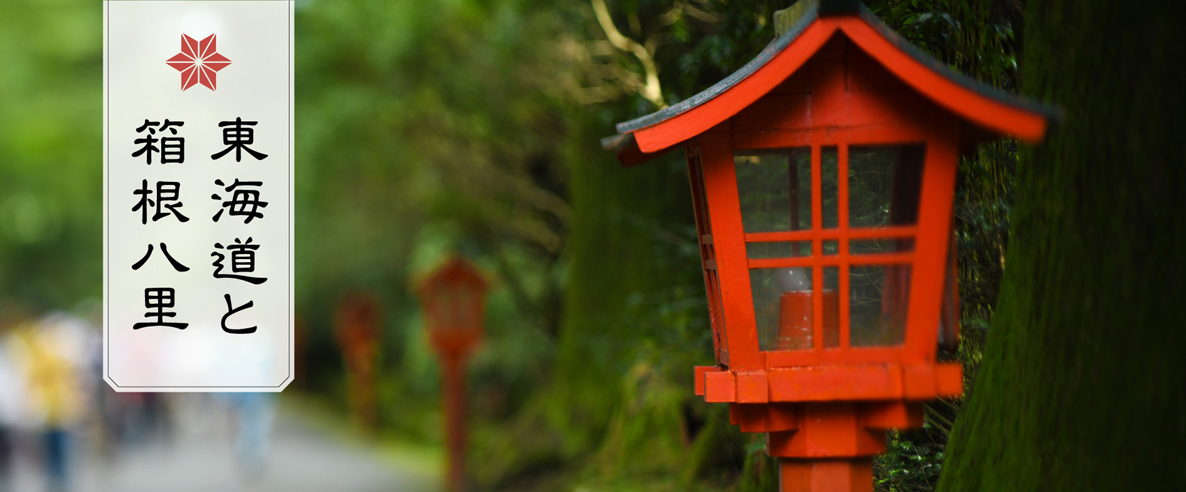

Tokaido
– History of the Tokaido
After Tokugawa Iyeyasu occupied Edo Castle in 1590, he developed five highways: the Tokaido, the Nakasendo, the Nikko Kaido, the Koshu Kaido, and the Oshu Kaido, and designated post towns along these highways in 1601. In 1604, the width of the highways was designated as five ken – about nine meters, and milestones were placed along the highways every ri (about 4 kilometers) by planting nettle trees or placing other objects on top of large earthen mounds. To specify the width of the highways, trees were planted along both sides of the highway, which also provided shade for travelers.
The Tokaido route from Hakone-Yumoto was changed from the original one along the ridge, which was used in the medieval Kamakura period (1185–1333), to a new one along the valley. The route from Motohakone to Hakone Post Town is mostly the same as the route from the medieval period. The route from Hakone Post Town to Mishima Post Town is a new route that was built on the southeast side of the medieval route that went over Hakone.
The Tokaido Hakone Hachiri which is also known as Hakone-ji or Hakone Ancient Highway, was so steep that it was regarded as Edo’s (which later became Tokyo) main protection against adversaries from the west. The West Slope on the Mishima side was thus developed along ridges to make it easier to find adversaries entering the Kanto region from the west, and the East Slope on the Odawara side along valleys to make it easier to intercept adversaries.
-Odawara Post Town
Odawara developed as a castle town after the Hojo clan entered the area at the end of the 15th century. The castle was then expanded, and the castle’s robust protection beat back military commanders such as Uesugi Kenshin and Takeda Shingen. However, Toyotomi Hideyoshi attacked Odawara in 1590, forcing the Hojo clan to surrender Odawara Castle. The territory was given to Tokugawa Ieyasu, and feudal lords who supported Tokugawa Ieyasu such as the Okubo clan and Inaba clan occupied Odawara Castle.
Odawara Post Town was established in 1601. It was the ninth post town after leaving Edo (Tokyo) and approximately 80 kilometers from Nihonbashi, a famous bridge in Edo and the start of the Tokaido. It is located 16 kilometers from Oiso Post Town, the eighth post town. Between these two post towns were Umesawa Intermediate Post Town and the Sakawa River.
In order to protect Edo, the Tokugawa shogunate did not built bridges over main rivers that the Tokaido crossed. The Sakawa River thus became a walk-across river in 1674, and travelers crossed the river either on the shoulders of porters or on palanquins. The distance to the next Post Town in Hakone was about 16 kilometers. Many travelers from Edo therefore stayed overnight at Odawara Post Town and prepared for the upcoming steep mountain hike over Hakone.
Odawara Post Town had four official inns called Honjin designated for feudal lords, and four sub-official inns called Waki-Honjin for their attendants – the most along the Tokaido. There were 95 regular inns at the end of the Edo period, which collectively made Odawara Post Town one of the largest post towns along the Tokaido.
– Hakone Post Town
Hakone Post Town was developed between Odawara Post Town and Mishima Post Town in 1618, 17 years after Tokugawa Ieyasu established the first post towns. The establishment of Hakone Post Town was said to be based on requests from feudal lords who visited Edo on a regular basis and who had had to endure hardship while travelling over the steep Hakone route.
The Tokugawa shogunate initially considered installing a post town at Motohakone. Yet, since it was the temple town of Hakone Gongen, the shogunate developed a new area besides Lake Ashinoko. Fifty inns and stores from Odawara Post Town and Mishima Post Town each were ordered to move to Hakone. The central part of the former Hakone Post Town still has places named Odawara-machi (Odawara town) and Mishima-machi.
Hakone Post Town then kept expanding as the tenth post town from Edo. Records indicate that there were two administrative offices, six official inns, one sub-official inn, and 36 regular inns at the end of the Edo period.
Hakone was and is also known for many hot springs and had multiple historic hot spring sites such as Yumoto which was said to be discovered in the Nara period (710 AD – 794 AD). Hot spring sites along the Nanayudo (literally “the road of seven hot springs”) that branch off from the Tokaido at Sammaibashi are the Yumoto, Tonosawa, Dogashima, Miyanoshita, Sokokura, Kiga, and Ashinoyu hot springs. Travelers enjoyed them from the early Edo period onwards.
Since Hakone was not far from Edo, it was popular among commoners as a tourist attraction. Many artists also depicted the area in ukiyo-e (woodblock) and other artworks.
-Mishima Post Town
Mishima, being centered around Mishima Taisha Shrine -the top shrine in Izu Province – has long flourished.
Mishima was the eleventh post town from the Nihonbashi bridge in Edo. It was an important area in terms of transportation as the Tokaido, the Shimoda Kaido, and the Koshudo roads all crossed in front of Mishima Taisha Shrine.
A magistrate’s office governing Izu Province – an area under the direct control of Tokugawa shogunate – was installed there in the early Edo period.
Four ‘towns’ named Denma, Kubo, Konakajima, and Dainakajima were the main areas with inns. These four areas became the heart of Mishima Post Town. Mishima Post Town had two official inns named Seko Honjin and Higuchi Honjin – the First and Second Official Inns. There were also three sub-official inns and 74 regular inns. East-bound travelers preparing for the hike to Hakone offered prayers at Mishima Taisha Shrine. West-bound travelers who had already crossed the difficult Hakone section celebrated their successful journey at Mishima Post Town.


